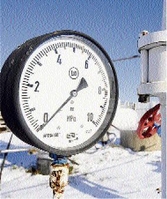
A pressure gauge on a natural gas pipeline. - File
The Bruce Golding administration has indicated that liquefied natural gas (LNG) is the preferred energy source for Jamaica going forward, but few details of the policy roll-out and the available options are in the public domain.
The government should, for example, indicate any variations in the previous bilateral memorandum of understandings (MOU) of 2004 under the P.J. Patterson administration and 2006 under Portia Simpson Miller being sought with the Government of Trinidad and Tobago and other potential suppliers.
Under the two previous agreements, Trinidad agreed to supply 158 million standard cubic feet of natural gas per day to Jamaica on a long-term basis.
However, the November 2004 MOU called for the fuel to be priced at the post-liquefaction stage when it is in liquid form as LNG.
The major difference with the April 2006 agreement was that under the new arrangement the gas would be priced on the basis of 'natural gas' as opposed to 'liquefied natural gas'. In other words, the later agreement called for the gas to be priced at the wellhead stage when still in its gaseous state.
The Simpson Miller administration posited that theproposed change in the pricing structure offered a potentially significant advantage to Jamaica as this would put the price more in line with the domestic gas market in Trinidad, as opposed to the price for LNG on the international market.
The conversion of the agreement from an 'LNG MOU' to a 'natural gas MOU' also provided future flexibility in the method of delivery of natural gas to Jamaica.
Cost-effective mode
The argument advanced suggested that while at the current time, LNG is the most cost-effective mode for the transport of gas from Trinidad to Jamaica, developing technologies for other delivery modes such as the transport of compressed natural gas (CNG) by ship would allow Jamaica to receive natural gas while bypassing the relatively expensive liquefaction and regasification processes associated with LNG.
Under the 2006 MOU, a joint-venture company was established - the Jamaica Natural Gas Project Company (JNGPC) - in which Trinidad would take a stake of up to 40 per cent.
In this arrangement, Jamaica would benefit from Trinidad's expertise at all stages of the project, and this would help to mitigate some of the additional responsibilities/costs that JNGPC would have to undertake under the terms of the MOU.
The company would have to pay: a liquefaction fee for the natural gas to be converted to LNG; the shipping cost to Jamaica; the storage and regasification costs; and the pipeline distribution costs to Jamaican gas users.
Construction schedule
When the Simpson Miller administration demitted office in 2007, work was advanced on the project development activities for the Jamaica Natural Gas Project, with Trinidad contributing 40 per cent of the costs involved.
The major activity undertaken was the conduct of the front end engineering design or FEED study which included updated cost estimates for implementing the project and a detailed construction schedule.
Preliminary investigations were also undertaken regarding the conversion of an existing LNG ship into an interim floating terminal which would allow for a speedier start-up time for the delivery of LNG to Jamaica and the attendant benefits in terms of reduced energy prices.
It is now up to the Golding administration to determine and disclose the strategy it will be pursuing, given the critical importance of Jamaica's rising energy bill.
renee.shirley@gleanerjm.com

A graphic design of a SeaNG compressed natural gas ship, as depicted on the company's brochure. Jamaica has explored the alternative of CNG supplies as well as liquefied natural gas.